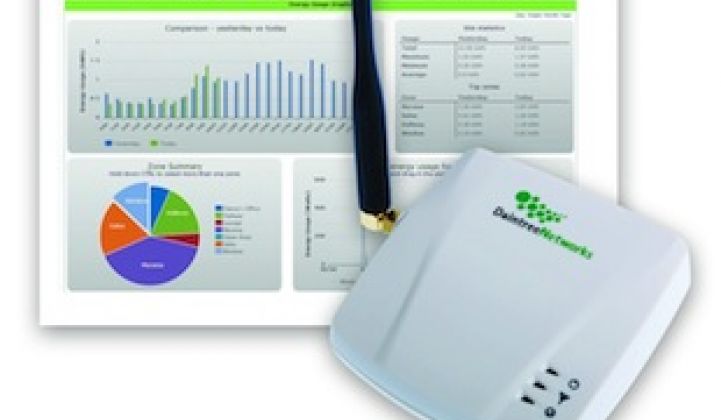Here’s a quick question for the branch-office managers, strip-mall tenants and factory-shift supervisors who happen to be reading this: When was the last time you optimized your programmable thermostat at work to maximize energy efficiency?
The honest answer to that question is probably “A long time ago” -- or “Never.” Indeed, plenty of studies out there show that so-called “programmable” thermostats are often ignored or misused, leaving their significant energy-saving potential untapped.
It would be nice if those same thermostats could be linked up with a ubiquitous wireless network in the building -- say, one that connects every light fixture. It would be even better if that platform actually saved energy for you, instead of making you figure out how it works.
That’s the idea behind an announcement last week from Daintree Networks, the Mountain View, Calif.-based startup that’s networked about 10 million square feet of commercial and industrial space via its ZigBee-based smart lighting platform. That adds up to a lot of lighting fixtures -- and, as of last week, Daintree’s ControlScope platform now supports programmable thermostats as well.
Specifically, Daintree and its channel partners are looking at thermostats that connect directly to rooftop HVAC units, CEO Danny Yu told me in an interview. They're used in multi-tenant retail, branch offices and other commercial spaces in the 10,000-to-50,000-square-foot range, he said -- bigger than that, and you start to see building management systems take over. Industrial customers also use these thermostats, since their heating and cooling needs aren’t as complex, and one thermostat per rooftop unit works about right for them, he said.
Because they’re hard-wired to a single rooftop unit, however, they lack any kind of networking or data collection capabilities, Yu said. And while they’re programmable, that doesn’t mean that the installer or the employees at the site, who aren’t energy experts, know how to program them.
Connecting them to the ControlScope network via a ZigBee radio, on the other hand, opens up a world of possibilities in both data collection and control, he said. And, while the cost of networking a few thermostats might be greater than the benefits achieved, simply adding them to an existing network makes it cost-effective to manage -- “Once you have the network, you’ve actually enabled the device,” is how he put it.
Daintree is definitely working with existing customers to extend their lighting networks to connect thermostats, Yu said. While he didn’t name any specific partners, last week’s press release did contain a testimonial from the CEO of energy efficiency partner SmartWatt Energy. Daintree has opened up its platform to third-party vendors, and is working with big integration partners such as Philips and Sylvania Lighting Services, as well as hardware partners California Eastern Labs (CEL) and Silicon Labs.
Needless to say, the company is not alone in envisioning a role for the smart lighting network that extends beyond lights. Most, if not all, of the startups in the space -- Adura (bought by Acuity last month), Enlighted, Daintree, Digital Lumens, Redwood Systems, et al. -- have plans to serve broader, machine-to-machine communications functions. Each startup has taken a slightly different approach, however, emphasizing different paths to market (integrator vs. OEM partner, for example) or mixes of technology (Digital Lumens and Redwood Systems are heavy into LEDs).
We’ve seen some other recent examples of leveraging the lighting network for HVAC optimization. Redwood Systems has opened its lighting platform to customers like SAP, which has built applications to feed its occupancy data into its Trane HVAC system and adjust accordingly. Adura and Cypress Envirosystems, which converts pre-1995 pneumatic thermostats to wirelessly controllable models, were working together back in 2009.
Lighting and HVAC should be friends in green buildings, but it’s hard to get two such different technologies to talk together. First of all, we’ve got a century’s worth of installed infrastructure to deal with -- it’s hard to get hard-wired light switches or pneumatic thermostats smart enough to share data and act on energy-saving commands.
Even on the cutting edge of networked, smart building technologies, lighting and HVAC take different paths. Heating and cooling sensors and control systems are naturally part of the building management system (BMS) built by the likes of Honeywell, Johnson Controls, Siemens, Schneider Electric, Emerson, et. al., where it makes sense to optimize assets that already exist -- something we’re seeing a lot of startups working on. But it also doesn't necessarily provide much visibility beyond itself, since it doesn’t need to build a new network to make things happen.
Lighting, which tends to be fairly un-networked in most buildings today beyond things like emergency lighting systems, presents an entirely separate challenge: making cost-effective improvements to thousands of endpoints, each striving to be as cheap and as efficient as possible. Indeed, it’s more of a machine-to-machine (M2M) networking problem. A number of the startups now tackling smart lighting have grown out of broader M2M applications, like industrial automation or, in the case of Daintree, testing and certification products.
An introduction to Daintree Networks' ControlScope Manager:



